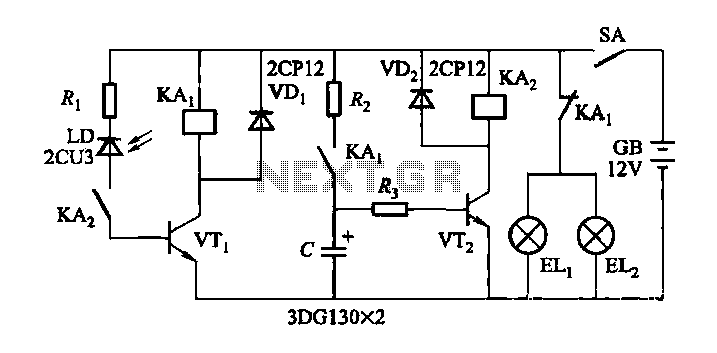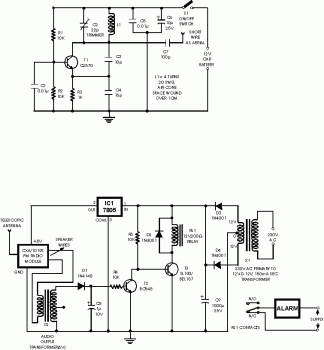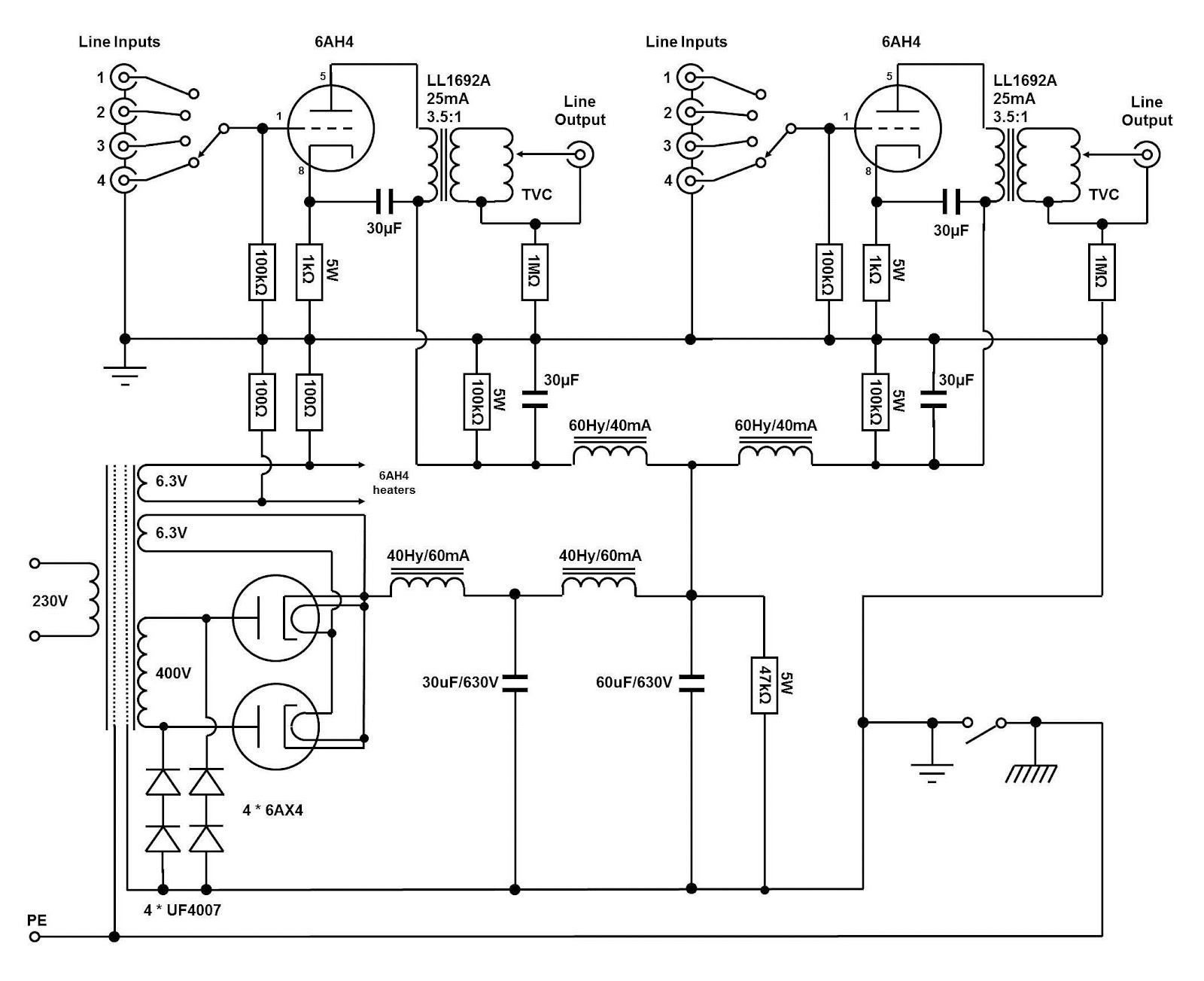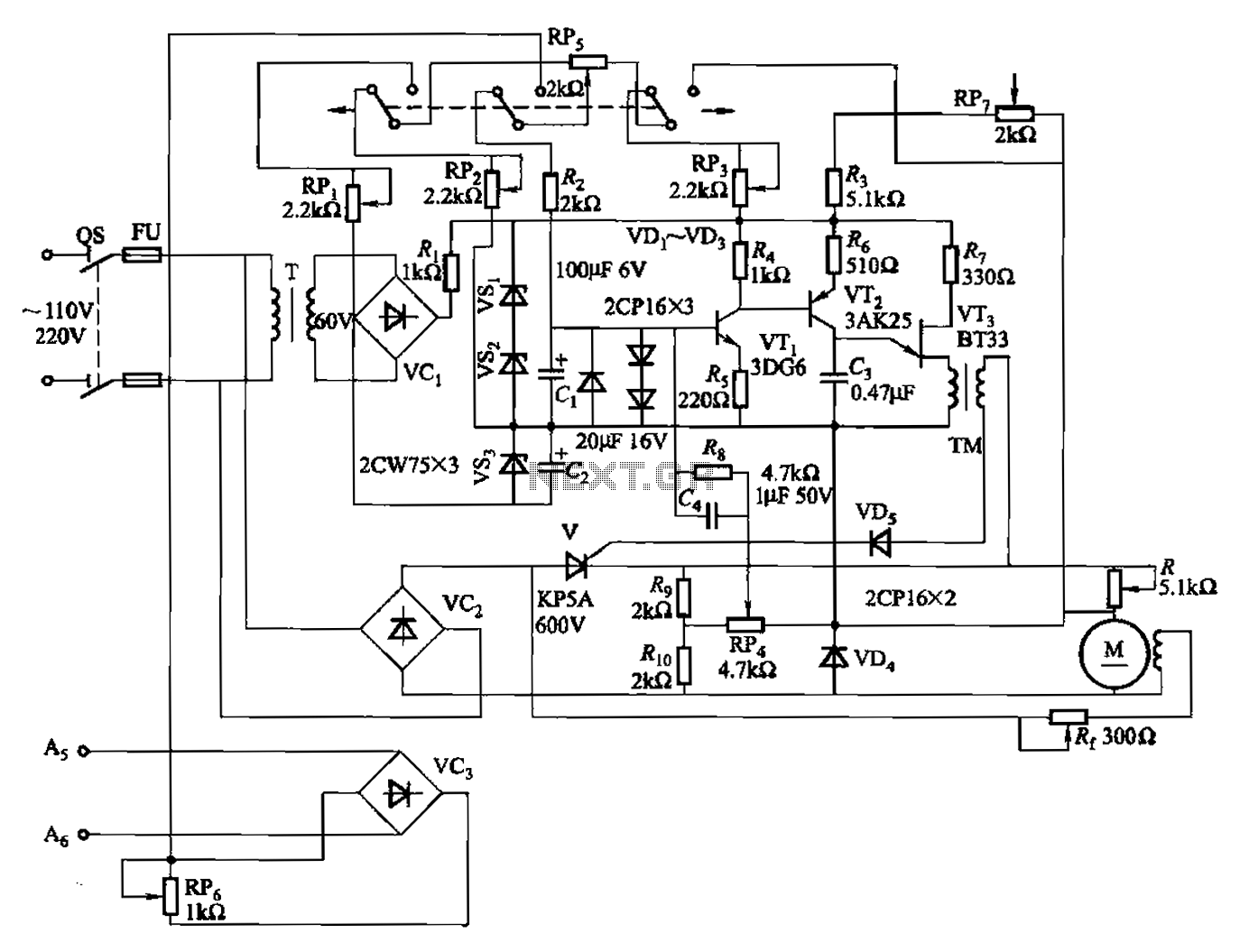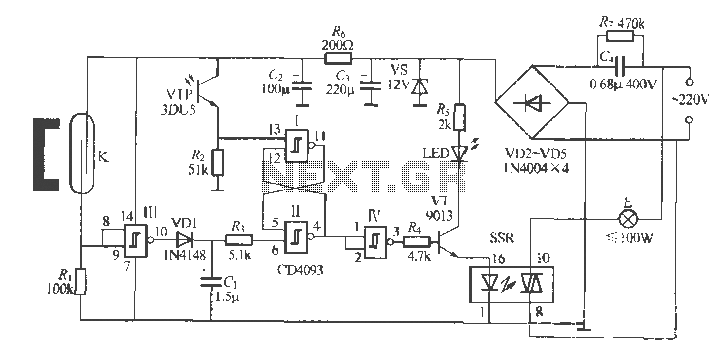
Four flashing lights string circuit 2
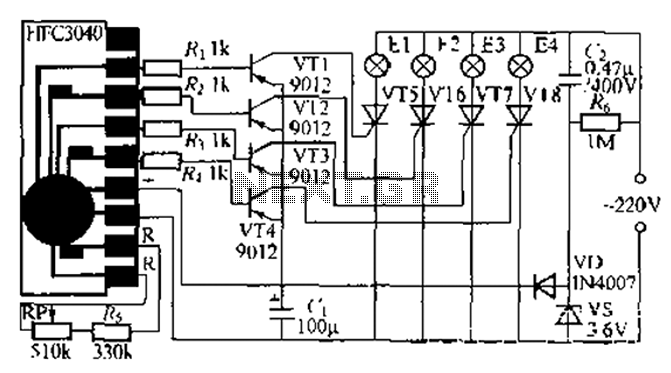
The circuit utilizes a four-way slowly dimming LED driver integrated with iU shoe production and a Qis four flashing lights string controller. The C3484 manifold is specifically designed to operate Ji lights with four lights that flash and slowly fade. The chip is packaged in a black soft paste measuring 2mm by 9mm. It is programmed to deactivate the case when requested, with the H1 output capable of directly driving a light-emitting diode (LED) or a crystal diode. Each output exhibits a phase difference of 90 degrees. The circuit features a simple half-wave rectifier capacitor step-down voltage regulator, providing a power output of approximately 3V for the manifold HFC3-184. The manifold has four outputs (Q1 - Q4) that sequentially receive negative-going pulses, which are transformed into positive pulses by external transistors (VT1 - VT4). These pulses then trigger thyristors (VT5 - VT8) to control the driving lights, enabling them to fade in a specific sequence (E1 - E4). The arrangement of the lights in space results in a visually appealing effect. A resistor (RP) is connected between the electrical terminal and resistance (R), allowing for external oscillation adjustments. The resistance of the light string can be modified by adjusting RP, which influences the flow rate of the light string. The output resistance values and cycle timing are indicated in a referenced table. The transistors (VT1 - VT4) are 9012-type silicon PNP transistors, while the thyristors (VT5 - VT8) are MCR100-S-type or other small unidirectional thyristors rated for 1A and 600V. Each lantern's power consumption should not exceed 1W. The RP is a small synthetic carbon potentiometer, and a polypropylene capacitor (C) rated at 4.0V is also required. The circuit is designed to operate normally and includes measures to prevent disturbances that could affect the thyristors. To mitigate potential issues, ceramic dielectric containers are suggested to be used in parallel with each gate electrode and cathode of the thyristors.
The four-way slowly dimming LED driver circuit is particularly effective for applications requiring a gradual lighting effect. The integration with the Qis flashing lights string controller enhances the visual display, making it suitable for decorative lighting, mood lighting, or signaling applications. The design features a robust architecture that allows for seamless transitions between lighting states, achieved through precise control of the output phases.
The use of the C3484 chip ensures efficient operation, allowing for direct control of LEDs or crystal diodes. The half-wave rectifier and voltage regulator work in tandem to maintain a stable output, which is critical for consistent performance across varying load conditions. The sequential input of negative-going pulses to the outputs ensures that the lights operate in a coordinated manner, creating a dynamic lighting sequence.
The external transistors serve as amplifiers for the input signals, ensuring that the thyristors are triggered effectively. This design choice enhances the reliability of the circuit, as the transistors can handle higher currents than the input signals alone. The selection of thyristors rated for high voltage and current ensures that the circuit can handle the demands of multiple LEDs without risk of failure.
Adjustability is a key feature of the design, with the inclusion of the potentiometer (RP) allowing users to fine-tune the brightness and flow rate of the light string. This flexibility is particularly beneficial in applications where ambient lighting conditions may vary.
Overall, this circuit design combines functionality, efficiency, and aesthetic appeal, making it a versatile solution for various lighting applications. The careful selection of components and the thoughtful arrangement of the circuit elements contribute to its effectiveness and reliability in delivering a visually engaging lighting experience. Clever use of a four-way slowly dimming LED driver integrated iU shoe production and Qis four flashing lights string controller. Ten Electronics Co., Ltd. Wenzhou production HF C3484 manifold is dedicated to play Ji light with four lights flashing slowly fades the chip, which uses black soft paste package measuring 2mm 9 iimm. It is programmed to delete the case when asked, H1 output can directly drive a light-emitting diode or a crystal diode, each output phase difference of 90.
Flashing. VD, vs, C, C blink R. Group ring simple half-wave rectifier capacitor step-down voltage regulator circuit, power and energy output 3V left some DC voltage supply manifold HFC3-184 use electricity. Manifold four outputs Ql - Q4 sequentially input {fj negative-going pulses, by R. ~ R. By an external transistor VTl - VT4 trans to zoom into a positive pulse followed by a touch hair thyristor VT5-VT8, called road driving lights take E1-E2 E3- F: 4 - F: 3- F.2 - - order Di lit by slowly fades, as long as the four lights for proper arrangement in space can be formed of water-efficient results.
RR manifold connected between an electrical terminal is busy RP and resistance R, meet their external oscillation resistor, adjust the RP can change the resistance of the flow rate of the light string, table 8-1 for the size of its output resistance of a cycle time off line. VTI --VT1 are Wu Ding with 9012-type silicon PNPj shake tube requires p 100; VTo-VTS are available MCRIOO-S-type cut and other small plastic products unidirectional thyristor (IA, 600V).
Fl ~ E4 each lantern power not exceeding 1.. W is appropriate. RP wFj type using small synthetic carbon potentiometer, C, requires CIm-4. ov poly propylene [U container, several other devices without special requirements. Bong circuit/f debugger, power that can make normal L. In order to prevent the thyristor VT5-VTS can receive a T r small disturbance can make [Bu Chang may be at each gate electrode and the cathode of the thyristor in parallel and then ask one o OirLF ceramic dielectric container malfunctioned acridine excluded.
The four-way slowly dimming LED driver circuit is particularly effective for applications requiring a gradual lighting effect. The integration with the Qis flashing lights string controller enhances the visual display, making it suitable for decorative lighting, mood lighting, or signaling applications. The design features a robust architecture that allows for seamless transitions between lighting states, achieved through precise control of the output phases.
The use of the C3484 chip ensures efficient operation, allowing for direct control of LEDs or crystal diodes. The half-wave rectifier and voltage regulator work in tandem to maintain a stable output, which is critical for consistent performance across varying load conditions. The sequential input of negative-going pulses to the outputs ensures that the lights operate in a coordinated manner, creating a dynamic lighting sequence.
The external transistors serve as amplifiers for the input signals, ensuring that the thyristors are triggered effectively. This design choice enhances the reliability of the circuit, as the transistors can handle higher currents than the input signals alone. The selection of thyristors rated for high voltage and current ensures that the circuit can handle the demands of multiple LEDs without risk of failure.
Adjustability is a key feature of the design, with the inclusion of the potentiometer (RP) allowing users to fine-tune the brightness and flow rate of the light string. This flexibility is particularly beneficial in applications where ambient lighting conditions may vary.
Overall, this circuit design combines functionality, efficiency, and aesthetic appeal, making it a versatile solution for various lighting applications. The careful selection of components and the thoughtful arrangement of the circuit elements contribute to its effectiveness and reliability in delivering a visually engaging lighting experience. Clever use of a four-way slowly dimming LED driver integrated iU shoe production and Qis four flashing lights string controller. Ten Electronics Co., Ltd. Wenzhou production HF C3484 manifold is dedicated to play Ji light with four lights flashing slowly fades the chip, which uses black soft paste package measuring 2mm 9 iimm. It is programmed to delete the case when asked, H1 output can directly drive a light-emitting diode or a crystal diode, each output phase difference of 90.
Flashing. VD, vs, C, C blink R. Group ring simple half-wave rectifier capacitor step-down voltage regulator circuit, power and energy output 3V left some DC voltage supply manifold HFC3-184 use electricity. Manifold four outputs Ql - Q4 sequentially input {fj negative-going pulses, by R. ~ R. By an external transistor VTl - VT4 trans to zoom into a positive pulse followed by a touch hair thyristor VT5-VT8, called road driving lights take E1-E2 E3- F: 4 - F: 3- F.2 - - order Di lit by slowly fades, as long as the four lights for proper arrangement in space can be formed of water-efficient results.
RR manifold connected between an electrical terminal is busy RP and resistance R, meet their external oscillation resistor, adjust the RP can change the resistance of the flow rate of the light string, table 8-1 for the size of its output resistance of a cycle time off line. VTI --VT1 are Wu Ding with 9012-type silicon PNPj shake tube requires p 100; VTo-VTS are available MCRIOO-S-type cut and other small plastic products unidirectional thyristor (IA, 600V).
Fl ~ E4 each lantern power not exceeding 1.. W is appropriate. RP wFj type using small synthetic carbon potentiometer, C, requires CIm-4. ov poly propylene [U container, several other devices without special requirements. Bong circuit/f debugger, power that can make normal L. In order to prevent the thyristor VT5-VTS can receive a T r small disturbance can make [Bu Chang may be at each gate electrode and the cathode of the thyristor in parallel and then ask one o OirLF ceramic dielectric container malfunctioned acridine excluded.

